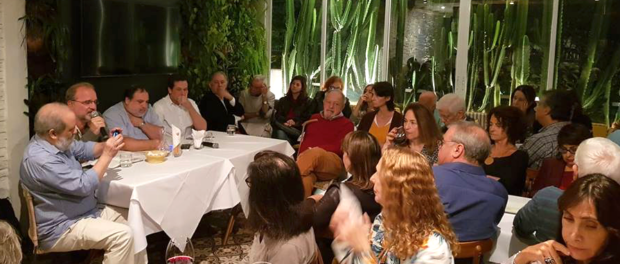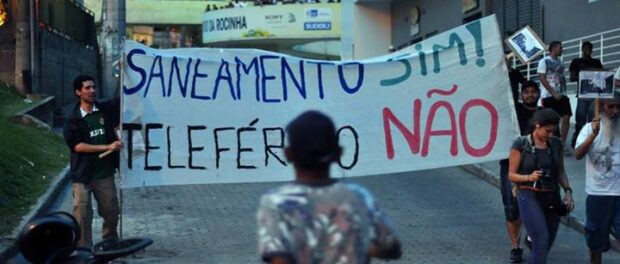
Some time since the last event, the OsteRio event series returned to a new location: Rio’s South Zone neighborhood of Jardim Botânico. Currently hosted by Institute for Studies on Labor and Society (IETS) executive director Manuel Thedim, the event series proposes to debate Rio de Janeiro’s future. At the May 28 edition, the discussion was about “urban planning, architecture and security in the city,” a theme of special interest in the context of rising fear and the narrative of insecurity that has justified a federal military intervention in Rio. A running theme across all the participants’ speeches was the recognition that matters of public security and urban development are intimately connected and manifest clearly in favelas, and that both dimensions need to be placed at the service of reducing inequality.
Discussing the impact of urban planning on security and the impact of security on urban planning, Pedro da Luz, current president of the Brazilian Institute of Architects’ Rio chapter (IAB-Rio), recalled the long-term role of the IAB in the fight for upgrading and integrating favelas without evictions in Brazilian cities, and its role of choosing the architects responsible for upgrading programs such as Favela-Bairro, Morar Carioca, and Rocinha’s Master Plan. For this last case, he recounted how even before an architecture firm was selected and thus with no guarantee they would win, the ultimately successful candidates organized two workshops in Rocinha, one of them inviting kids to draw what they wanted for the community, in a way that mobilized people within the neighborhood. The public authorities, however, changed the project’s parameters in an authoritarian manner and, instead of the four funicular trams planned to improve mobility at a cost of around R$70 million (including the necessary resettlements), they announced a cable car costing R$700 million, which was widely resisted by residents.
Rocinha, in particular, is a much talked-about favela, not only because of urban interventions like the aforementioned mobility initiative but also because of the conflicts it experienced in the months preceding the federal military intervention. For da Luz, one reason the Pacifying Police Units (UPPs) failed to guarantee security in the community is that the UPP policy is based on a spacial logic, such that the model for a small favela like Santa Marta could not be transplanted to a favela like Rocinha.
“Rio’s favelas have amazing potential. On my walks there’s an endless stream of vans stopping at Prazeres, at Fallet, to take photos. And they distribute a bunch of leaflets about bars and restaurants to tourists! And they go there!” he said. “The city has never seen [favelas] in a positive light. It’s important to see them as potential, as resistance. As a population that is able to live close to work in this way, as an economy that runs. Recognizing the problems without romanticizing. Do we want to keep being this divided city? That has such a different degree of urbanization between Ipanema and São Gonçalo?”
Pedro Strozenberg, the executive secretary of the Institute for Religious Studies (ISER) and ombudsman for the State of Rio de Janeiro’s Public Defenders Office, commented on the return to the atmosphere felt in the nineties—of fear and insecurity on the one hand, but also of renovation and hope, of innovative and creative public interventions. He criticized shallow urban public security solutions, such as the case of Nilópolis’ city government’s proposal to build walls around highways. “Security for whom?” he questioned. For him, urban planning cannot be a mechanism of exclusion: “Of course order is important. But how does that order coexist with freedom, and not exclusion?”
Noting that a high number of homicides are committed by the State itself, Strozenberg asserted that nonetheless security challenges are the responsibility of the State, which must make the inclusion of social participation and the reduction of inequalities its priorities. He also said that the more general challenge for decision makers is the balance of emphasis between security politics and other dimensions of public administration: “When you spend more on the prison system and security to the detriment of health and education, you determine the kind of city we’re going to have.” In the specific case of urbanism policies, he stated we have to pay attention to the thin line that sets apart urban planning driven by security, which reproduces inequalities and State violence, and urban planning that includes security.
Architect, urbanist, and O Globo columnist Washingon Fajardo highlighted that not all citizens are using public space in the same way and that a big part of the population, particularly Afro-Brazilians, are frequently excluded from it. “If the favela represents a solution for [those people] who don’t have the State, we need to correct that neglect, but also guarantee that these youth access the internal spaces in our cities.” For him, the city has to be a space of real dialogue and not just a conversation between those who are alike.
He also highlighted that development in Rio has been happening “through hiccups, not continuity,” referencing the successive favela upgrading programs that have overlapped with each other without taking into account the knowledge learned via the previous project. Besides continuity from one policy to another, he stated it’s also necessary to include the notion of agency in policies on housing, monuments, and urban planning.
Manuel Thedim, as the discussion facilitator, connected the speeches by stating that, for him, the future will be driven by values of diversity, empathy and exchange, all seen through a territorial perspective. He believes it is the gathering of different people in a territory and the circulation within that territory that can take us closer to a solution.

